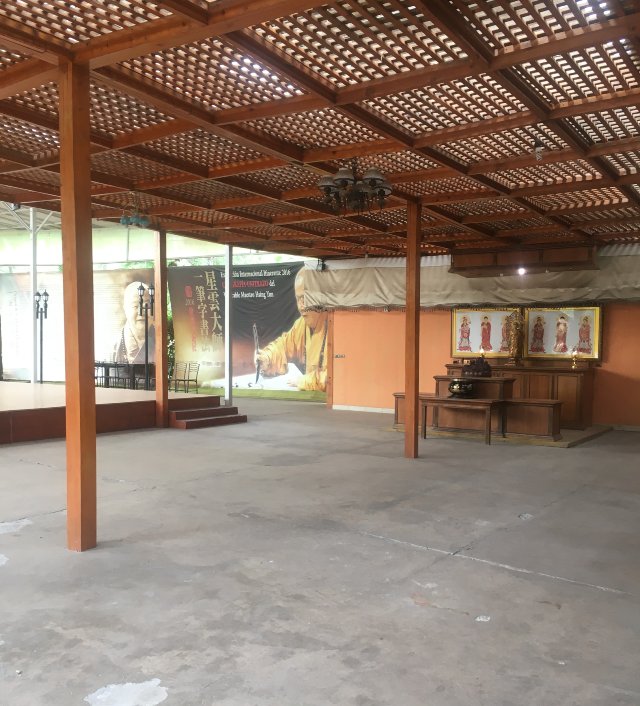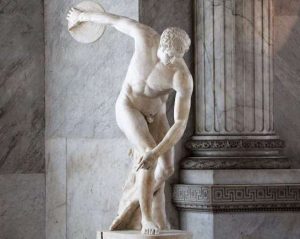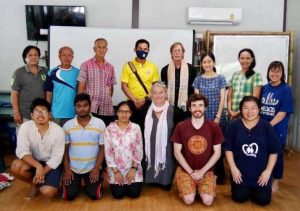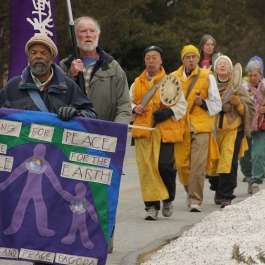This article was originally published in Buddhistdoor en Español. The following is a translation of that article.
While I was traveling by bus from San Borja Bus Station in Santiago toward Talagante, Chile, I thought about the fact that my previous visit to the Fo Guang Shan temple had been two years earlier. This time I had been inspired by their call to meditation held at the temple every Sunday, an activity that arose in order to pray and meditate for an end to the violence that has become increasingly common and widespread in Chile in recent months.

The Fo Guang Shan order arrived in Brazil in 1992, when Rulai-si was founded in Sao Paulo—the first monastery and headquarters for the other temples in South America. In 2000, the Buddhist teachers Miaomu and Miaokuang arrived in Chile and started working to establish a temple in the outskirts of the capital. Thanks to financial support from Chinese benefactors, construction on the temple commenced at a rural site in Talagante, some 30 kilometers outside Santiago. After a couple years spent obtaining permits and building, the space was inaugurated on 5 October 2002.
In addition to the temple, a headquarters was founded in the city of Iquique in northern Chile. These offices were created to meet the religious needs of Chinese migrants and to respond to their cultural influence, as the first Chinese arrivals and communities in Chile were in this area. While the history of the Chinese in Iquique dates back a long time, most new immigrants from Asia—especially in and after the 1990s—made their way to growing migrant communities in Santiago. Chinese Buddhist support for the temple was essential. Nonetheless, a location near the capital had the further aim of both attracting Chileans seeking a refuge in Buddhism for their spiritual lives and to secure those Chileans’ commitment to working with the institution.
The Fo Guang Shan temple in Talagante is made up of a large main hall, a room for making offerings of light and a merit room, a meditation room, dining room, kitchen, bedrooms, and a house where the nuns live.

Meditation started at 10:30 in the morning. We were a group of no more than 20 people, all Chilean. The teacher Juequan had arrived a couple months earlier who, along with the other teachers, Youguang and Youshang, led the activity, which consisted of reading the Sutra Amituo with other prayers and offering food, to then dedicate several minutes to meditating in silence. At the end, two of the teachers took the food offered at the altar to prepare lunch. At this time, Youshang, the only Spanish speaker, told us about the life of master Hsing Yun, the founder of the Fo Guang Shan monastic order, whose presence was felt through photos, books, prayers, and calligraphy hanging on the temple walls. Master Hsing Yun is a leader and advocate of the practice of Humanistic Buddhism, which seeks to disseminate and propagate Buddhism in a modern globalized world via culture, education, charity, and practice.
Since the time at which the temple was founded, a series of practices have been held there, ranging from religious ceremonies, retreats, and celebrations such as weddings and baptisms, to cultural and educational activities, including language and cookery classes, celebration of the Chinese New Year, martial arts classes, and visits of educational institutions. The summer camp for children merits mention, held every summer. The teachers, together with temple volunteers, organize a series of activities in which the children learn the virtues of Buddhism, meditation, tai-chi—a Chinese internal martial art—and teamwork. During the days of the camp, the children eat vegetarian meals, meditate, and participate in ceremonies. In addition to this activity, the nuns extend invitations to young volunteers so that they can attend camps in other South American countries, including Argentina and Brazil.
This diversity of actions that characterizes the institution has helped it to become better known and also ensures its adaptation to modern-day social needs, achieving empathy with its surroundings. Resources in the field of communications create a dialogue space for Buddhist doctrine, covering the visual and cognitive mainstays of modern societies.
After Youshang finished telling us about the life of the master Hsing Yun, we prayed for the violence in the country to end and that we could find a peaceful solution to the problems afflicting Chilean society. After that, we took a break for lunch to enjoy a delicious vegetarian meal. While we ate, I didn’t recognize any of the people who tended to work with the temple. Several of the guests were attending for the first time. While speaking to Youguang, she commented that it was not easy to create connections with the Chileans who could adapt most easily, with knowledge of the Chinese language and culture who are interested in Buddhist doctrine, who could then support them in spreading it. She also mentioned the difficulty in motivating them to keep cooperating and working with the institution, as many of them do not forge a great commitment to the temple and, further, that volunteers also tend to stay for a fixed period of time and then leave. I think these difficulties are intimately related to two factors of Chilean society: first, the way in which Asian religions have historically been established in Latin America, and second, Chileans’ rejection of institutions.
The role of the first spiritual movements—including the Theosophical Society (see Luarte 2019)—was fundamental, as they transmitted Buddhist thought by combining it with other philosophies, creating eclectic doctrines whose aspirations were aimed at individual spiritual improvement. The majority were established as centers or institutes, not linked to any religion that identifies them as such. The latter heeds a trend to consider Buddhism as a “philosophy of life.” Although Chile is predominantly a Christian country, secularization and religious pluralization has had an impact. This process leads to “believers in their own way” who “are actually believers in astrology, tarot, reincarnation, New Age and all types of contemporary mysticisms and neo-esoterisms.” (Parker 2008, 306) These types of believers have a hereditary connection to Christian traditions, particularly Catholicism, but they disassociate themselves from any institution, moving away from the rites, dogmas, and rules, seeking alternatives that they feel enrich their spiritual lives in a more individual way.
The effort that Fo Guang Shan has made to establish itself in a different culture is clear, simplifying and creating a spiritual discourse that is much more adapted to modern-day societies. Its presence and influence in Chile is increasing, with noteworthy work by the nuns to maintain and encourage people visiting the temple and attending the different activities and ceremonies. There is similarly constant care and service to Chile’s situation, not only the social unrest and protests of October 2019, but also to events such as the fires in the city of Valparaíso, where the nuns traveled to pray and provide food. However, the tendency of “believers in their own style” to reject all that is institutional is becoming stronger and more present. This makes it difficult to train a solid body of Chilean devotees and volunteers who are committed to Fo Guang Shan, who in turn could be a bridge for others to become interested in the Buddhist teaching.
There is undoubtedly a long road of reflection and reformulation ahead for Fo Guang Shan so that it can become established in the best way possible and have followers with a greater commitment to the institution. To do so, I think it is important, among other factors, to have an in-depth understanding of the desires, interests, perceptions, and questions that have motivated people to visit the temple. In this way we can understand their concept of Buddhism and the other ways we could transmit the doctrine to improve its reception among Chileans, thus leading to more people committing to Buddhism.
References
Parker, Cristián. 2008. “Pluralismo religioso, educación y ciudadanía,” Sociedade e Estado, Brasília, v. 23, n. 2: 281–353.
Luarte, Felipe. 2019. “Una aproximación histórica al (Neo-) Hinduismo en Chile,” Nuevos diálogos: Asia y África desde la mirada latinoamericana (Ríos, Maire, Álvarez, et al.), Mexico City: Mexico City College.
See more













